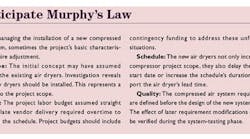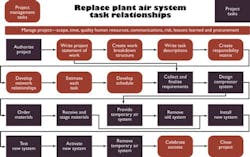Have you ever taken on a major maintenance activity, such as replacing the compressed air system (compressors, air dryers and distribution system), and not completed it on time or within budget? When you were done, was this critical utility available in the right places with the right pressure and right flow? Does your team take on multiple major tasks that are vying for the same limited resources?
Such large undertakings aren't recurring maintenance activities and should be managed as projects. Effectively managing a project or multiple simultaneous projects requires skills that aren't necessarily intuitive to plant maintenance personnel. The development, acceptance and implementation of a standardized project management process can improve an organization's performance and bottom line.
Master the vocabulary
Project management uses unique terminology. When terms are understood, a project runs to a successful completion more effectively. "A Guide to the Project Management Body of Knowledge" by the Project Management Institute (PMBOK Guide) defines key terms, some of which are discussed here.
A project is a temporary endeavor undertaken to produce a unique product, service or result. It has a beginning and an end and requires resources. Stakeholder refers to people actively involved in a project or who can influence it positively or negatively. A program is a group of related projects managed in a coordinated way. The project life cycle represents a collection of generally sequenced work phases specifically identified for a project.
Replacing a compressed air system (see Figure 1) could be considered to be three separate projects. The first provides a temporary source of compressed air, another dismantles and removes the old system, and the last furnishes and installs the new system. The combination is referred to as a program. The program life cycle includes establishing requirements, designing the system, providing the temporary air, purchasing equipment, and constructing and installing the new system. Initiating any of these tasks starts the program. When the shop finally is using the new air system, the program is complete. The multiple phases (projects) constitute the life cycle for that program, and every project or program has a life cycle.
Figure 1. It's important to identify project tasks and their relationships to each other.
Seize the opportunity
Effective project management controls and monitors four basic characteristics cope, cost, schedule and quality.
Develop your project scope by identifying the final product requirements that are included and not included. Establish and document the scope early in the project life cycle. A change process also is required to handle scope evolution during the project life cycle.
The project budget, in conjunction with the scope, must be approved early in the project life cycle. Collect and analyze costs against the budget throughout the project life cycle to avoid overruns.
Develop the project's schedule after the scope, cost estimates and network diagram are completed and resources have been applied. The schedule must be tracked during the entire project life cycle.
Establish the project quality standards early in the project life cycle, during the requirements definitions stage. The finished project should meet not exceed the established quality standards.
The balance of the project management opportunity consists of four categories: people, process, performance and tools.
People
Various studies indicate that 70% to 80% of a project manager's time and effort involves working with people and their issues. Project management is not for people who don't like or can't work with teams of people.
Project managers should be trained on project management basics before being assigned a project. People skills and teambuilding are especially important in fostering cooperation toward project completion. Many colleges and universities provide project management continuing education that only improves project performance. Corporate in-house training, vendors and professional organizations also provide a wide range of training opportunities. Recent studies indicate that the number of project teams with little or no formal training is decreasing. Maintaining this trend should improve project management performance.
Resource-loading the project team members scheduling the time required for project tasks in accordance with a person's available time is a major key to increasing project management performance. Continually starting and stopping work on a task and juggling several projects isn't effective. Every time you stop working on a task, it will take some effort to get back up to speed. Doing this several times a day will decrease your overall productivity. For example, it makes no sense to quit mowing the lawn halfway through to start washing half your car, then stopping to finish the lawn and vacuum the house before finishing the car. It's more effective to remain on a single task and complete it before beginning another.
Embrace the process
Effectively managing multiple projects requires that each project be properly managed individually using a standardized, repeatable process. This doesn't imply that the same tasks must be completed on every project regardless of scope. Rather, similar projects should have similar, well-defined task lists. Stakeholders must understand, use and support the adopted processes. The results of the project management process must also be able to be measured and reported using consistent metrics.
A documented, repeatable project management process improves performance. Many methods are available for achieving this end. The PMBOK Guide illustrates one of many generally accepted methods that identify nine major project management areas:
- Project integration
- Scope
- Time
- Cost
- Quality
- Human resources
- Communication
- Risk
- Procurement
After adopting a project management process, manage it properly. This requires limiting the amount of work entering the system, working to establish priorities, assigning knowledgeable project managers and, possibly, establishing a project office.
The performance of the project management process, like your maintenance process, must be monitored, analyzed, improved and communicated continually to extract its greatest value. These processes should incur the least amount of expense to ensure year-end profits.
Tools and methods
Multiple tools are available to assist your project management efforts. Some Microsoft products, including Project, Access, Excel, Word and Visio, will be helpful. Sophisticated, stand-alone project management software packages also are available. Select a tool set that's appropriate for your effort. The tools should complement the primary tool the project management process you adopted earlier.
A few "tricks of the trade" for establishing a project management process include a Statement of Work (SOW) to identify the critical aspects of the project title, objectives, deliverables, deliverables acceptance criteria, assumptions, ground rules, constraints, major milestones, high-level schedule and, most importantly, signatures of the project manager and management. This provides the authorization to begin a project.
General project management tasks include developing a project charter, writing a statement of work, creating a work breakdown structure and writing task descriptions. Tasks also require a responsibility matrix that develops network relationships and estimates the cost and duration of each task. Developing a schedule and managing risk are as important as beginning implementation, tracking costs and schedule, documenting lessons learned and closing out the project.
Management review requires a process to prioritize incoming projects. Every project must have a sustainable business case. Establish project priorities and limit candidate choices to fewer than five.
The templates used for the Work Breakdown Structure (WBS) offer a standardized way to repeat projects.
A description for each task in your project provides information similar to the Statement of Work. Even if team members say they know what they are doing, it's vital to document task descriptions to ensure the whole project team understands them, not just the individual assigned to the task. Establish the delivery criteria for each task to enable you to know what constitutes "task completed."
A network diagram establishes the relationships that exist among tasks. It establishes the predecessor and successor relationships that underlie the schedule.
Metrics quantify not only each project's performance but also the performance of the process. Typical metrics include the number of projects open over time, open and closure activity, project aging, projects by priority and project assignment by group. Metrics can be pulled from a project tracking system.
Effective project management methods bolster the performance of your maintenance organization. Identify and confirm with management the need for project management improvement. Develop and implement a project management process that can handle multiple projects, then implement it, including training and communication of those involved. Measure the results and make corrections as required.
David Hambelton, PMP, is senior project manager with the Boeing Commercial Airplane Group in Everett, Wash. E-mail him at [email protected] or call him at (425) 717-5721.
Figures provided by Boeing Commercial Airplane Group


